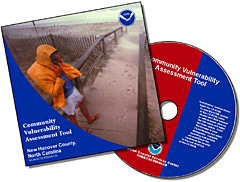
|
|
Some of the biggest challenges facing coastal communities involve coastal hazards. Such natural hazards include hurricanes, tsunamis, erosion, and harmful algal blooms. It is the job of local and state governments to reduce the negative environmental, social, and economic impact that these natural hazards can have on their communities. NOAA’s National Ocean Service (NOS) is a part of this effort. NOS provides helpful hazard-related information and tools to state and local coastal programs. Much of this work is developed at the NOAA Coastal Services Center and involves training, information dissemination, and tools and methodologies created to assist in hazards assessment, response, and mitigation. Training is an important component of this effort. Topics include managing natural hazards in coastal areas and determining which portions of a community are most at risk. Courses are designed for state and local officials and can be taught at the Center or brought to the customer.
The vulnerability assessment tool was developed to help local and state officials determine and prioritize specific vulnerabilities. Communities use this information to make future development plans and design effective evacuation and rebuilding plans when a disaster strikes. The Vulnerability Assessment Techniques and Applications Web site Web site provides researchers and practitioners with access to more than 40 hazard vulnerability assessment case studies that have been successfully applied in the Western Hemisphere.
For the West Coast, the Protecting our Ports and Harbors Web site Web site focuses on earthquake and tsunami hazards. In addition to general information about hazards, this site includes hazard risk information, mitigation strategies, and an Internet mapping application that displays hazard data for Oregon ports. |
|
||||||||||||||||||||||||
|
||||||||||||||||||||||||||
|
Revised April 21, 2003 | Questions, Comments? Contact Us | Report Error On This Page | Disclaimer | User Survey |

